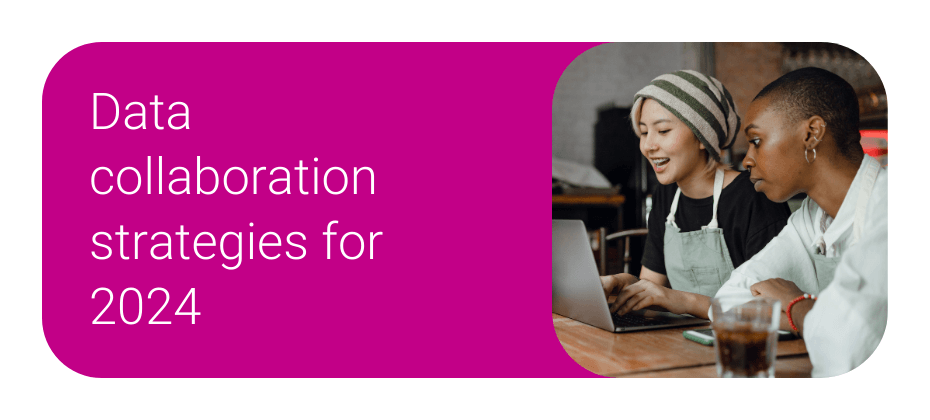Marketing trends
The latest insights on the shifts shaping advertising, media, and technology—all in one place. From emerging consumer behaviors to innovations in data, identity, and targeting, we cover the trends that matter most to marketers and advertisers. Whether you’re navigating seasonal campaigns, planning next quarter’s strategy, or exploring the future of retail media and programmatic, stay informed here.

At the recent Beet Retreat 2023 in Santa Monica, a fireside chat featuring Kimberly Gilberti, Experian’s Chief Product Officer, shed light on how connected TV (CTV) is changing content delivery and introducing a profound shift in audience engagement and advertising strategies. In this blog post, we’ll recap Gilberti’s discussion about advertising on CTV. CTV's transformative impact on media consumption CTV brings together the nostalgia of traditional television and the cutting-edge capabilities of digital targeting, opening new doors for advertisers to connect more meaningfully with audiences. This integration heralds a new wave of viewer engagement opportunities. The revolution goes beyond altering content consumption modes; it fundamentally transforms how audiences interact with media. Advertisers now have the tools to forge deeper, more personalized connections with their audience, thanks to CTV. "The evolution of media is exciting, offering endless opportunities due to the vast inventory and engaged audiences. The key to using this is understanding the consumer, the 'who' behind the viewing."kimberly gilberti, chief product officer The evolution of advertising on CTV In CTV, traditional advertising strategies are being re-evaluated. Advertisers must pivot to meet changing viewer trends, focusing on campaigns that resonate on a personal level and harness the targeted delivery capabilities of the medium. Data and technology stand at the forefront of advertising on CTV. Effective collection, analysis, and application of audience data are crucial for creating impactful CTV campaigns. Advanced analytics tools are essential in deciphering complex viewer habits. Companies like Experian are key players, offering the necessary tools and insights for advertisers to navigate the CTV space effectively. "Experian's unique data assets are incredibly valuable. We understand consumers wherever they are, connecting the offline and online worlds. Our database, rooted in real people's information, is extensive and privacy-focused, covering virtually every U.S. household."kimberly gilberti, chief product officer The complexities and opportunities in advertising on CTV Even though the CTV landscape is filled with vast opportunities and significant challenges, one major hurdle is accurately identifying viewers within shared household accounts, complicating targeted advertising on CTV efforts. Additionally, the fragmentation of content across multiple streaming platforms amplifies the challenge of reaching specific audience segments. The presence of 'walled gardens' adds another layer of complexity in achieving a comprehensive understanding of audience behavior across different platforms. Despite these challenges, the potential for effective, personalized advertising on CTV is immense. Key to unlocking this potential is the accurate measurement of ROI and the alignment of content with viewer preferences. These areas of focus underscore the need for sophisticated identity resolution and audience analysis solutions. Collaboration is the key to unlocking CTV's potential The future of advertising on CTV relies on collaboration. Joint efforts from advertisers, agencies, technology providers, and publishers are essential for sharing data and insights while maintaining consumer privacy. This collective approach is pivotal in tackling the challenges of advertising on CTV and harnessing its full potential. As the industry dives deeper into the CTV landscape, insights from Beet Retreat 2023 and leaders like Gilberti underscore the importance of understanding and engaging with your consumers. The collaborative efforts of the industry, bolstered by technological and data-driven expertise, are critical in capitalizing on the power of CTV. Experian’s Collaboration solution connects our client's and partner's data to unlock more robust insights, smarter activation, and more holistic measurement for online and offline media efforts. To learn more about what our data collaboration services can do for your business in this new era of CTV, visit our website or connect with a member of our team today. Start collaborating with Experian Latest posts

Industry leaders recently gathered at the influential Beet Retreat 2023 conference held in Santa Monica, sharing forward-looking perspectives on the future of advertising. This renowned event known for its diverse mix of leaders from TV, agencies, advertising, and technology sectors, was enriched by insights from Experian’s very own Chris Feo, SVP of Sales & Partnerships, and Kimberly Gilberti, Chief Product Officer. Both Feo and Gilberti brought their expertise and perspectives for harnessing the potential of high-growth connected TV (CTV) advertising. The era of connected everything at Beet Retreat 2023 In the “Era of Connected Everything,” panel, Feo dived into the concept of a ‘connected everything’ world. He emphasized the importance of balancing consumer and privacy expectations with the increasing integration of AI and machine learning. “As decisioning evolves, creative tech and data derived from creative scale will play a bigger role.”chris feo, svp, sales & partnerships Feo further discussed the potential of creative technology, particularly in how AI and machine learning could revolutionize content personalization. He cited examples where the same creative content is used indiscriminately across diverse demographics, suggesting a future where creative content adapts and performs well for a variety of audience identities. Experian's balanced approach at Beet Retreat 2023 During a fireside chat, Gilberti shared her vision on the transformative role of television in the advertising technology landscape. “Connecting exposure to business outcomes is the holy grail of measuring CTV and effectiveness.”kimberly gilberti, chief product officer Her insights reflected the growing interplay between digital and traditional TV advertising, and the opportunities arising from this convergence. Gilberti emphasized the critical role of data analytics in enabling advertisers to tailor content more effectively to diverse TV audiences. She envisioned a future where the integration of digital strategies and traditional TV advertising create a more cohesive and impactful AdTech approach. Future focus: Diversification and partnerships Both Feo and Gilberti underscored the need for advertisers to diversify their partnerships. By working with a variety of partners, you can mitigate risks and foster innovation, ensuring you are not overly dependent on a single channel or approach. Navigate what’s next with Experian Experian's contributions at Beat Retreat 2023 underscore our pivotal role in the AdTech industry. With a unique balance of offline and online data expertise, we are not just adapting to changes but leading the way in innovation and strategy. Our insights and approaches, as highlighted by Feo and Gilberti, demonstrate our commitment to guiding the industry through its rapid evolution, making our role indispensable in the future of advertising technology. At Experian, we’re your partner in data-driven marketing and can help make your interactions more meaningful. To learn more, connect with a member of our team today. Connect with us Latest posts

Walled gardens produce the majority of digital advertising revenue and will continue to be a major marketing challenge according to industry leaders.

Discover 2024 data collaboration strategies for better business intelligence. Learn to use data sharing, APIs, and secure frameworks.

The holiday season is just around the corner, and retailers and marketers are gearing up for the busiest shopping period of the year. It's crucial to understand how consumer behavior is evolving and what emerging trends to expect. Experian's 2023 Holiday spending trends and insights report analyzes recent trends, consumer spending habits, and anticipates what's to come in 2023 to help you deliver a top-notch shopping experience this holiday season. In this blog post, we'll cover three key insights from our report. 1. Consumers are shopping earlier It's no secret that December has always been the go-to month for consumers when it comes to holiday spending. However, holiday shopping now starts earlier, particularly with online sales. This can be attributed to a surge in promotions and deals, enticing shoppers to open their wallets ahead of time, giving a significant boost to holiday sales. Notably, Cyber Week sales have proven to be an influential factor, accounting for 8% of total consumer holiday spending. Experian tip Reach the right shoppers with your promotions with sell-side targeting. This powerful approach gives you control over where your ads are placed while ensuring maximum visibility through direct connections with publishers. Whether on mobile, web, or CTV, this seamless ad experience will engage your audience effectively. 2. Online sales are on the rise The popularity of online holiday sales is continuously growing, surpassing in-store shopping. There has been a consistent 1% year-over-year increase in online sales, while in-store sales have seen a 1% decrease. "It’s easier for consumers to comparison shop for large ticket items online that they might find at a mass retailer or office supply store. Consumers prefer to have larger, bulkier items shipped directly to their home for minimal cost. By shopping online, consumers can save time since they don’t need to wait in checkout lines." Anna Liparoto, Sr. Account Executive, Retail & CPG Although online sales currently make up only one-third of all holiday shopping, there is immense potential for further expansion. Mass retailers and office, electronics, and games industries particularly excel in online holiday sales. While in-store purchases remain the primary choice for holiday shoppers, consumer online and offline activities intersect before the final purchase. Experian tip Take advantage of the surge in online shopping by diversifying your marketing channels. An agnostic identity graph can bring together device and media data, capturing valuable user insights. By gaining a holistic view of your target audience, you'll be able to optimize your ad spend and allocate resources effectively, ultimately boosting your return on investment. "Omnichannel targeting during the upcoming holiday season will continue to prove to be the best way to reach scale and maximize ROI across all marketing channels."Joe Ligé, Head of Enterprise Demand Partnerships 3. 2023 holiday spending will be on par with 2022 During the holiday season in 2022, consumer spending showed an anticipated increase, although the growth rate was slightly lower compared to previous years. October saw a surge in average consumer spending, indicating a swift response to early discounts and promotions offered by retailers. As the holiday season progressed, holiday spending gradually slowed down and reached a level similar to that of the previous year. Overall, there was a modest 2% growth. Looking into the future, if economic conditions remain stable in the second half of 2023, we can expect holiday spending to align with the figures from last year. Experian tip To truly maximize impact, consider data enrichment. By diving deeper into your target audience's preferences and behaviors, you can better tailor your strategies and seamlessly integrate the enriched data across various channels. This allows you to unlock the true potential of your ad inventory, creating more meaningful connections with your audience. Download our new 2025 report Get ready for the holiday shopping season with Experian's 2025 Holiday spending trends and insights report, in collaboration with GroundTruth. Inside you'll find: When shoppers plan to buy Why stores still drive results Where marketers are placing their bets How AI is shaping discovery To access to all of our predictions for this year's holiday shopping season, download our 2025 Holiday spending trends and insights report today. Download now Contact us today Latest posts

The cookieless future is here, and it's time to start thinking about how you will adapt your strategies to this new reality. In a cookieless world, you will need to find new ways to identify and track users across devices. This will require reliance on first-party data, contextual advertising, and alternative identifiers that respect user privacy. To shed light on this topic, we hosted a panel discussion at Cannes, featuring industry leaders from Cint, Direct Digital Holdings, the IAB, MiQ, Tatari, and Experian. In this blog post, we'll explore the future of identity in cookieless advertising. We'll discuss the challenges and opportunities that this new era presents, and we'll offer our tips for how to stay ahead of the curve. How cookieless advertising is evolving Programmatic advertising is experiencing multiple changes. Let's dive into three key things you should know. Cookie deprecation One significant change is cookie deprecation, which has implications for tracking and targeting. Additionally, understanding the concept of Return on Advertising Spend (ROAS) is becoming increasingly crucial. The demand and supply-side are coming closer together Demand-side platforms (DSPs) and supply-side platforms (SSPs) have traditionally been seen as two separate entities. DSPs are used by advertisers to buy ad space, while SSPs are used by publishers to sell ad space. However, in recent years, there has been a trend toward the two sides coming closer together. This is due to three key factors: The rise of header bidding Header bidding is a process where publishers sell their ad space to multiple buyers in a single auction. This allows publishers to get the best possible price for their ad space, and it also allows advertisers to target their ads more effectively. Cookie deprecation As third-party cookies are phased out, advertisers need to find new ways to track users, and they are turning to SSPs for help. SSPs can provide advertisers with data about users, such as their demographics and interests. This data can be used to target ads more effectively. The increasing importance of data Advertisers are increasingly looking for ways to target their ads more effectively, and they need data to do this. SSPs have access to a wealth of user data, and they're willing to share this data with advertisers. This is helping to bridge the gap between the two sides. The trend toward the demand-side and supply-side coming closer together is good news for advertisers and publishers. It means that they can work together to deliver more relevant ads to their users. Measuring and tracking diverse types of media The media measurement landscape is rapidly evolving to accommodate new types of media, such as digital out-of-home (DOOH). With ad inventory expanding comes the challenge of establishing identities and connecting them with what advertisers and agencies want to track. Measurement providers are now being asked to accurately capture instances when individuals are exposed to advertisements at a bus stop in New York City, for example, and tracking their journey and purchase decisions, such as buying a Pepsi. To navigate cookieless advertising and measurement, we must prioritize building a strong foundational identity framework. What you should focus on in a cookieless advertising era In a cookieless advertising era, you will need to focus on two key things: frequency capping and authentic identity. Frequency capping Frequency capping is a practice of limiting the number of times an ad is shown to a user. This is important in cookieless advertising because it helps to prevent users from being bombarded with ads. It also helps to ensure that ads are more effective, as users are less likely to ignore or click on ads that they have seen too many times. Frequency capping is often overhyped and yet overlooked. Instead of solely focusing on frequency, consider approaching it from an identity perspective. One solution could be to achieve a perfect balance between reaching a wider audience and avoiding excessive repetition. By increasing reach in every programmatic buy, you naturally mitigate frequency control concerns. Authentic identity The need for authentic identities in a digital and programmatic ecosystem is undeniable. While we explore ways to connect cookies, mobile ads, and other elements, it's crucial to remember who we are as real individuals. By using anonymized personal identifying information (PII) as a foundation, we can derive insights about households and individuals and set effective frequency caps across different channels. Don't solely focus on devices and behaviors in your cookieless advertising strategy and remember the true value of people and their identities. What’s next for cookieless advertising? The deprecation of third-party cookies is a major challenge for the digital advertising industry. Advertisers will need to find new ways to track users and target their ads. Here are three specific trends that we can expect to see in cookieless advertising. First-party data is moving in-house Many major media companies, equipped with valuable identifier and first-party data, are choosing to bring it in-house. They are focused on using their data internally rather than sharing it externally. "Many larger media companies are opting to bring their identifier and first-party data in-house, creating more walled gardens. It seems that companies are prioritizing data control within their own walls instead of sharing it externally."laura manning, svp, measurement, cint Fragmentation will continue The number of identifiers used to track people online is growing rapidly. In an average household, over a 60-day period, there are 22 different identifiers present. This number is only going to increase as we move away from cookies and toward other identifiers. This fragmentation makes it difficult to track people accurately and deliver targeted advertising. This means that we need new identity solutions that can help make sense of these new identifiers and provide a more accurate view of people. A portfolio of solutions will address signal loss Advertisers are taking a variety of approaches to cookieless advertising. A few of the solutions include: Working with alternative IDs. This refers to using alternative identifiers to cookies, such as mobile device IDs or email addresses. These identifiers can be used to track people across different websites and devices, even without cookies. Working with data index at a geo level. This refers to using data from a third-party provider to get a better understanding of people's location. This information can be used to target ads more effectively. Working with publisher first-party data that's been aggregated to a cohort level. This refers to using data that is collected directly from publishers, such as website traffic data or purchase history. This data can be used to create more personalized ads. Working with contextual solutions. This refers to using contextual data, such as the content of a website or the weather, to target ads. This can help to ensure that ads are relevant to the user's interests. "Cookie deprecation is often exaggerated, and alternate solutions are already emerging. As data moves closer to publishers and first-party data gains prominence, the industry will adapt to the changes."mark walker, ceo, direct digital holdings There is no one-size-fits-all solution for cookies, and you will need to be flexible and adopt a variety of different approaches. How will these solutions work together? You can take a waterfall approach to cookieless advertising. A waterfall approach is a process where advertisers bid on ad impressions in sequential order. The first advertiser to meet the minimum bid price wins the impression. In the context of cookieless advertising, a waterfall approach can be used to prioritize different targeting signals. For example, you might start by bidding on impressions that have a Ramp ID, then move on to impressions that have a geo-contextual signal, and finally bid on impressions that have no signal at all. This is a flexible approach that can be adapted to different needs and budgets. Watch our Cannes panel for more on cookieless advertising We hosted a panel in Cannes that covered the future of identity in cookieless advertising. Check out the full recording below to hear what leaders from Cint, Direct Digital Holdings, the IAB, MiQ, Tatari, and Experian had to say. Watch now Check out more Cannes content: Our key takeaways from Cannes Lions 2023 Insights from a first-time attendee Four new marketing strategies for 2023 Exploring the opportunities in streaming TV advertising Maximize ad targeting with supply-side advertising Follow us on LinkedIn or sign up for our email newsletter for more informative content on the latest industry insights and data-driven marketing. Get in touch Latest posts

The rise of streaming TV advertising is revolutionizing the marketing landscape, bringing together the best of traditional television's broad audience reach and digital's precise targeting capabilities. Marketers now have a new platform to explore, but it comes with its own set of challenges and opportunities. To shed light on this topic, we hosted a panel discussion at Cannes, featuring industry leaders from AMC Networks, Disney, OMG, Paramount, Roku, and Experian. In this blog post, we'll explore the effectiveness of TV as a performance channel and audience targeting. TV as a performance channel Television has come a long way over the years. The evolution of linear TV to connected TV (CTV) is opening new possibilities for targeting and performance measurement, like what we're accustomed to in search and display. However, there's still a way to go. What's preventing us from fully realizing the potential of CTV? Let's explore what's holding us back. Three challenges Advertisers are captivated by CTV, a media platform that combines the best features of TV and digital advertising. With its unparalleled data and identity capabilities, alongside the immersive TV experience, it has the potential to be a powerful performance channel. However, we still face three challenges as performance dollars take center stage. "CTV is a valuable household device that provides direct audience insights. However, to gain a comprehensive understanding of the household and the individuals in the household, we need different techniques. The implementation of such methodologies from user level profiles to algorithmic inferences are still evolving across different companies." Louqman parampath, vp, product, roku Client education Performance marketers and agencies are still primarily focused on social and search. It's important to reassure them that CTV aligns with their established standards. Optimize KPIs We need to address the challenges around attribution and incrementality. We should optimize for the KPIs that performance marketers desire, which are different from the metrics commonly used in social media and search marketing. Results-driven interactions You should invest in interactive ad formats and novel experiences to give users clickable options that deliver the instant impact of performance marketing. While conversions and purchases can happen after seeing an ad thanks to view-through attribution, your goal should be to make video ad experiences feel like performance-based engagements. This transition is crucial to building trust and familiarity among performance marketers and agencies. Strategies to effectively reach audiences across different mediums There are various mediums to connect with consumers -- TV, digital, and mobile offer multiple avenues. Which strategies should you prioritize? Data interoperability When it comes to buying unified audiences, programmatically is the easiest route. By prioritizing data interoperability, you can ensure a seamless buying experience across all screens. "At Disney, we focus on data interoperability with industry solutions such as The Trade Desk/UID2, Google PAIR, and Experian and the LUID, making it effortless to buy unified audiences programmatically across all screens. With an identity graph as the foundation of our tech stack, we help our clients reach their target audience across linear, digital, and streaming properties."jamie power, SVP, addressable sales, disney Advanced targeting capabilities in linear TV Don't limit your perspective on television consumption to traditional streaming platforms alone. While streaming is popular, it's equally exciting to see advanced targeting capabilities integrated into linear television. Viewer habits are shifting, with appointment TV becoming a thing of the past. Today, viewers have more options to watch a variety of programming, regardless of its age. "Streaming has become another platform for viewers to consume programming, and it's exciting to see digital targeting capabilities being applied to linear TV. Viewer behavior has changed, with more opportunities to consume programs at different times, so it's important to use targeting capabilities like linear addressable to effectively reach the audience across multiple channels."evan adlman, Evp, commercial sales & revenue operations, amc networks While live premieres still attract a substantial audience, utilize linear addressable targeting to reach viewers across channels. By doing so, you can ensure your message reaches the right viewers at the right time. The viewership landscape has diversified - it's time to adjust our strategies. Make TV viewing patterns predictable To bring predictability to the unpredictable and fragmented landscape of TV, advertisers can create products that simplify and unify the viewing experience. This allows users to effortlessly transition between episodes, resulting in a cohesive and engaging viewing journey. Watch our Cannes panel for more on the future of streaming TV advertising We hosted a panel in Cannes that covered the future of streaming TV advertising. Check out the full recording below to hear what leaders from AMC Networks, Disney, OMG, Paramount, Roku, and Experian had to say. Watch now Check out more Cannes content: Our key takeaways from Cannes Lions 2023 Insights from a first-time attendee Four new marketing strategies for 2023 The future of identity in cookieless advertising Maximize ad targeting with supply-side advertising Follow us on LinkedIn or sign up for our email newsletter for more informative content on the latest industry insights and data-driven marketing. Get in touch Latest posts

As a marketer, you know that the digital landscape is always changing. That's why it's important to make sure you're equipped with the right tools every step of the way - no matter how rapidly things change. You want to ensure your strategies and tactics stay ahead of any changes in technology or consumer behavior, so what new marketing strategies should be in your toolbox in 2023? Discover what industry leaders from Experian, Adweek, FreeWheel, Tubi, and Instacart had to say about what should be in every marketer's toolbox in 2023 at Cannes. Keep reading to learn the top four new marketing strategies you need in your marketing toolbox for 2023 and beyond. 1. A plan for signal loss The first item you should have in your marketing toolbox is a plan for signal loss. The phasing out of third-party cookies presents both a challenge and an opportunity. This shift not only poses challenges but also opens up opportunities for alternative strategies. On the one hand, it makes it more difficult to track users across channels and measure the effectiveness of marketing campaigns. On the other hand, it forces marketers to focus on building relationships with their customers and collecting first-party data. Consumer behavior is changing When we consider signal loss in a traditional sense, we think of the implementation of iOS 14, where we couldn't track click-based data from campaigns. It's important to reflect on the fact that the paid media ecosystem needed to adapt to new consumer realities. Younger demographics are less likely to click on ads and instead engage in video environments. They discover brands through platforms like TikTok or Instagram. It's crucial to understand how people behave, where they discover products, and where influence takes place. This understanding becomes even more vital when targeting a young audience demographic. Four things to consider when planning for signal loss There are four things you should consider when building out a plan to address signal loss and fragmentation. Channel diversification You need to reach your customers on the channels where they are already spending time, such as social media, email, and your own website. You should work with platforms that have first-party data to understand how your customers interact with your brand. Data privacy You need to be transparent about how you are collecting and using customer data. You should also anonymize data whenever possible. First-party data First-party data is now more crucial than ever, awakening its importance in shaping our actions. The combination of channel diversification and first-party data will be essential in the years to come. By focusing on these two areas, you can build stronger customer relationships and create more effective marketing campaigns. Contextual targeting Contextual targeting is emerging as a viable method to deliver more relevant content to your intended audience. By embracing signal loss, the alternative new marketing strategies that are emerging as a result, and adopting a privacy-centric mindset, you can navigate cookie deprecation. 2. Collaboration The second item you should have in your marketing toolbox is collaboration within the AdTech ecosystem. To address signal loss and changes in privacy, moving toward a more collaborative, holistic marketing ecosystem is key. Two ways we can achieve better collaboration Here are two ways we can create better collaboration in the AdTech ecosystem. Enable interoperability We should aim to create an ecosystem that fosters collaboration between marketers, publishers, advertisers, ad tech companies, and more. When we enable seamless interoperability, everyone can use the best data available. Use clean rooms We are witnessing a growing trend of collaboration between parties, where buyers and sellers share data in these secure environments. Clean rooms can help us develop data strategies in a controlled manner. 3. Generative artificial intelligence (AI) The third tool you should have in your marketing toolbox is generative AI. Benefits of implementing AI There are three main benefits to implementing AI within your marketing strategy. Enables creativity Although AI and machine learning have long been part of our toolbox, this moment marks an extraordinary acceleration that expands our capabilities. Copywriters can now create visuals, and art directors can write compelling copy. It's an extension of what we're capable of, potentially alleviating the burden of repetitive tasks and enabling more time for collaboration, creativity, and strategic thinking. By embracing generative AI, we can preserve valuable talent, prevent burnout, and invigorate the advertising industry. Enables more personalization The rise of personalization with AI has significantly increased the demand for tailored experiences. People now willingly allow AI agents to read their emails, hoping for quicker and easier responses. This shift signifies a change in the previous emphasis on privacy and consumer preferences. Consumers now see the value in exchanging personal information for more targeted services. E-commerce has already witnessed this transformation with customized ads based on individual preferences and behaviors. For instance, if a CPG brand notices you're not purchasing meat, they won't serve you ads for meat products. However, it's crucial to strike the right balance between being useful and intrusive. Users want relevant information that aligns with their needs without feeling intruded upon. As we navigate this path, we must ensure that personalization remains beneficial and respectful of user preferences. Helps drive impactful results and customer satisfaction The tool is a perfect analogy for improving your job performance and business operations. Having the right data input to feed the machine is crucial, just like using the right ingredients to cook a perfect meal. Keeping the consumer in mind throughout the process is key. You can ensure customer satisfaction by putting the right ingredients in and allowing the machine to work its magic. Scaling up, repeating, and refining the process will drive impactful results. 4. First-party data The fourth item you should have in your marketing toolbox is first-party data. Benefits of implementing a first-party data strategy Moving from a third-party cookie world to a first-party cookie world brings about significant transformation. Here are two benefits of implementing a first-party data strategy. Greater accuracy The shift to first-party cookies ensures greater accuracy, enabling us to establish critical mass through secure partnerships. This empowers us to strengthen and refine our personalization capabilities, much like Amazon's ability to anticipate customer needs before they arise. When you can predict and understand customer behaviors with remarkable precision, you can reach your customers with tailored and creative ads. "Building a robust first-party data strategy should be a central discussion for marketers, involving key stakeholders such as CEOs and CMOs. Quality and precise data are paramount, and while first-party relationships with consumers form the foundation, even established brands benefit from strategic partnerships. Together, we can unlock the potential of accurate and meaningful data-driven marketing."jeremy hlavacek, cco, experian Identify high-growth audiences First-party data can help you identify audiences with the greatest growth potential, ultimately optimizing marketing dollars for greater efficiency. Watch our Cannes panel for more new marketing strategies for 2023 We hosted a panel with Adweek in Cannes that covered what should be in every marketer's toolbox this year. Check out the full recording below to hear from leaders at Tubi, Freewheel, Instacart, Adweek, and Experian. Watch now Check out more Cannes content: Our key takeaways from Cannes Lions 2023 Insights from a first-time attendee Exploring the opportunities in streaming TV advertising The future of identity in cookieless advertising Maximize ad targeting with supply-side advertising Follow us on LinkedIn or sign up for our email newsletter for more informative content on the latest industry insights and data-driven marketing. Get in touch Latest posts

It's back-to-school season. Knowing your target audience is an essential piece of planning a successful back-to-school marketing campaign. To get the most out of your marketing investment this back-to-school season, it’s important to understand how to identify and segment back-to-school shoppers so you can make sure that the right message reaches the right group at the right time. In this blog post, we'll cover how you can segment your target audience to create and deliver custom messaging tailored to individual groups. We'll discuss segmentation methods that uncover: Who they are Where they live What type of person they are How they behave and spend Here are our tips to accurately define and target your back-to-school marketing audience. Maximize back-to-school marketing with customer segmentation Customer segmentation is the process of dividing your audience into smaller groups based on common characteristics such as demographics, behaviors, psychographics, geographics, and more. The purpose of customer segmentation is to create a more personalized and effective approach to marketing. By understanding the unique needs and preferences of each segment, you can tailor your messaging, campaigns, and content to resonate with your customers on a deeper level. Benefits of customer segmentation Three benefits of customer segmentation include: Improved audience targeting Higher engagement rates Increased ROI Instead of addressing your entire customer base with generic messaging, segmentation enables you to deliver custom campaign messaging that speaks directly to each group. This personalized approach helps build trust and loyalty with your customers over time. Customer segmentation also allows you to better understand your customers, their motivations, and pain points, ultimately leading to more effective marketing campaigns. Types of customer segmentation When it comes to segmenting your customers, there are several methods to consider. By experimenting with different approaches, you can find the best fit for your business. Keep in mind that the most effective customer segments will differ depending on the industry. Let's review four types of customer segmentation that you can implement as part of your back-to-school marketing strategy. 1. Demographic segmentation Demographic segmentation categorizes consumers into groups based on shared demographic characteristics such as age, gender, income, occupation, marital status, and family size. For example, targeting college students during the back-to-school season with promotions on laptops is likely to be more effective than targeting retirees who may have less interest in such products. 2. Behavioral segmentation Behavioral segmentation divides customers into groups based on their demonstrated behaviors. This method sorts customers by their knowledge of products or services, attitudes toward brands, likes/dislikes about offers, responses to promotions, purchasing tendencies, and usage of products/services. Behavioral segmentation can help you identify the highest-spending customer segments, so you can budget and target more effectively. Through this type of segmentation, you can analyze each group's patterns, discover trends, and plan informed marketing moves for the future. In a back-to-school campaign, you could use behavioral segmentation to identify students who prefer to shop locally. You could then target students who value supporting local businesses and emphasize the importance of buying from local retailers during the back-to-school season. 3. Geographic segmentation Geographic segmentation involves dividing your target market into groups based on their physical locations. Geographic segmentation reveals aspects of a local market, including physical location, climate, culture, population density, and language. In a back-to-school campaign, you could use geographic segmentation to identify target audiences in colder climates who may be more interested in winter clothing and gear. You could also use geographic segmentation to target students living in college towns with messaging that speaks directly to campus life. 4. Psychographic segmentation Psychographic segmentation groups customers based on psychological factors such as lifestyle, interests, personality, and values. In a back-to-school campaign, you could use psychographic segmentation to target students who value sustainable practices, promote eco-friendly products, or offer incentives for recycling and reusing items. Watch our 2024 video for tips from industry leaders for back-to-school In our new Q&A video with Experian experts, we explore changing consumer behaviors surrounding back-to-school shopping in 2024. In the video, we discuss: Anticipated shifts in consumer behaviors and shopping habits Tactics we predict marketers will employ to navigate signal loss Which channels will be the most successful And more! Watch now Get in touch Latest posts